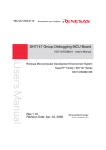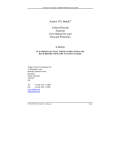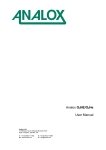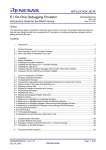Download LC Series Software Configuration & System Calibration
Transcript
LC Series Software Configuration & System Calibration User Manual - 122x32 Display Analox Ltd. 15 Ellerbeck Court, Stokesley Business Park North Yorkshire, TS9 5PT, UK T: +44 (0)1642 711400 F: +44 (0)1642 713900 W: www.analox.net E: [email protected] The LC Series Manuals The LC range of environmental monitoring systems have a range of manuals covering various aspects of their operation: LC system installation and hardware configuration manual This manual covers all of the hardware aspects of the LC environmental monitoring systems. Each of the component parts of the system is discussed and hardware configuration is explained. Dimensional drawings are included of most of the LC variations. LC software configuration and system calibration manual The operation of the LC system is discussed as well as the software configuration and calibration procedures. Note: This manual is a generic manual for the latest firmware that is currently in use. While every effort is made to maintain compatibility with older versions certain features and screen references may change when used in conjunction with different firmware versions. The firmware version is displayed during power up and when the MENU key is pressed in later versions. Document Ref: P0102-804-00 - January 2015 LC Series Software Configuration & System Calibration User Manual - 122x32 Display List of Contents 1 2 3 4 5 6 7 Introduction....................................................................................................................... 1-2 1.1 Software ..................................................................................................................... 1-2 Switch on .......................................................................................................................... 2-2 Operation.......................................................................................................................... 3-3 3.1 Accessing the system configuration menu ................................................................ 3-4 3.2 Alarm conditions ........................................................................................................ 3-4 3.2.1 Gas level alarm ................................................................................................... 3-4 3.2.2 Fault alarm .......................................................................................................... 3-5 3.2.3 Accepting the alarm ............................................................................................ 3-5 3.3 Display settings.......................................................................................................... 3-6 3.3.1 Backlight time ...................................................................................................... 3-6 3.4 Changing the password ............................................................................................. 3-7 Software configuration. .................................................................................................... 4-8 4.1 Controller ................................................................................................................. 4-10 4.1.1 Start up delay .................................................................................................... 4-10 4.1.2 Fault delay ......................................................................................................... 4-11 4.1.3 Sounder ............................................................................................................. 4-11 4.1.4 Decimal point .................................................................................................... 4-12 4.1.5 Backlight ............................................................................................................ 4-12 4.1.6 Password .......................................................................................................... 4-13 4.2 Channel ................................................................................................................... 4-14 4.2.1 Alarm Levels ..................................................................................................... 4-14 4.2.2 Alarm delay ....................................................................................................... 4-15 4.2.3 Alarm hysteresis ................................................................................................ 4-15 4.2.4 Calibration ......................................................................................................... 4-16 4.3 Set voltage ............................................................................................................... 4-19 4.4 Sensor type.............................................................................................................. 4-20 4.4.1 Special Sensor Type – N2 ................................................................................. 4-21 4.5 Relay options ........................................................................................................... 4-22 4.5.1 Level 3 alarm relays .......................................................................................... 4-23 4.6 Inhibit ....................................................................................................................... 4-24 4.7 View ......................................................................................................................... 4-25 4.8 Engineer .................................................................................................................. 4-26 4.8.1 Devices.............................................................................................................. 4-26 4.8.2 Analogue output ................................................................................................ 4-27 4.8.3 Input simulation ................................................................................................. 4-27 System reset .................................................................................................................. 5-28 5.1 Soft reset. ................................................................................................................ 5-28 PC programming software. ............................................................................................ 6-29 Firmware update ............................................................................................................ 7-34 7.1 Creating a new project. ............................................................................................ 7-34 7.2 Programming the LC controller. ............................................................................... 7-41 Document Ref: P0102-804-00 - January 2015 LC Series Software Configuration & System Calibration User Manual - 122x32 Display 1 Introduction The LC range of environmental monitoring systems has been designed primarily with gas detection in mind. However, the versatility of the range extends its application to other aspects of industry where monitoring of remotely connected sensors is required. The specification allows the use of any sensor that can produce a voltage or current output within a specified range. 1.1 Software The firmware (software) within each of the control units has had to be carefully designed to allow the full potential of the system to be utilised. In many cases the software is identical between the different control units, but configuration changes have allowed the system to be used for completely different applications. Incorrect configuration may cause the system to function unsatisfactorily and in extreme cases of incorrect configuration, alarms would not be raised. Analox Ltd are happy to offer advice when configuration changes become necessary to ensure a reliable and responsive system is maintained. 2 Switch on Before connecting power to the system: 1. Read: LC series system installation and hardware configuration manual LC series software configuration and system calibration manual 2. Ensure correct hardware configuration has been performed for each input. 3. Ensure the correct voltage setting has been selected at the power supply. Switch on the power supply to the system. The firmware version will appear for several seconds on the LCD graphical display. A bar graph will be displayed during the system power up delay setting as follows: SSCL LC4 Series Firmware V1.0.6 The display will then change to the System Default Screen, see section 3, This lists details associated with all configured channels. Document Ref: P0102-804-00 - January 2015 Page 2-2 LC Series Software Configuration & System Calibration User Manual - 122x32 Display 3 Operation Before connecting power to the system: 4. Read: LC series system installation and hardware configuration manual LC series software configuration and system calibration manual 5. Ensure correct hardware configuration has been performed for each input. 6. Ensure the correct voltage setting has been selected at the power supply. Switch on the power supply to the system. The firmware version will appear for several seconds on the LCD graphical display. A bar graph will be displayed during the system power up delay setting as follows: SSCL LC4 Series Firmware V1.0.6 The display will then change to the System Default Screen, see section 3, This lists details associated with all configured channels. Document Ref: P0102-804-00 - January 2015 Page 3-3 LC Series Software Configuration & System Calibration User Manual - 122x32 Display 3.1 Accessing the system configuration menu All of the features provided by the LC software are accessed from the system configuration menu. To access the system configuration menu: 1. Press menu (from the system default screen). 2. The Password Entry screen will appear if the password is set. ENTER PASSWORD 1 2 3 GO MENU 3. 4. 5. 3.2 3.2.1 Enter the correct password and press OK. The default password for the system is 123 (If an incorrect password is entered the system will revert to the standard system default screen). The following screen will be seen when the correct password is entered. Alarm conditions Gas level alarm Gas level alarms can be of two types 1. Level 1 alarm 2. Level 2 alarm 3. Level 3 alarm ( not available on LC1 ) 3.2.1.1 Level 1 alarm The LC control unit has stored within its configuration, gas levels at which alarms should be raised. e.g. Channel 3 may be detecting methane (0 to 100% LEL). Its alarm levels may be set as 15%, 30% LEL and 50% LEL. CO2 C1 0.0 % O2 C2 20.9 % 16 LEL CH4 Alarm L1 C3 0 PPM H2S C4 Document Ref: P0102-804-00 - January 2015 Page 3-4 LC Series Software Configuration & System Calibration User Manual - 122x32 Display Each time a gas concentration is detected in excess of those set in the alarm levels configuration, in the above example 15% LEL, the LC Control Unit will raise an alarm. The way in which the alarm is raised will depend upon the system configuration and the ancillary sounders and beacons fitted to the system. Note: An alarm will be indicated on the display by the word Alarm appearing next to the channel in alarm, the Alarm status will flash and indicate the alarm level. The local Alarm Red LEDs will light to indicate an Alarm condition, regardless of the display mode selected. 3.2.2 Fault alarm The control unit will indicate a fault if a detector head indicates less than 10% of its measuring range (i.e. below 2.4mA signal level). Any channel that is in a fault condition is detected by the LC control unit which generates a fault message, drives the local Yellow LED and activates the fault relay. CO2 Fault C1 -1.0 % O2 C2 20.9 % 0 LEL CH4 C3 0 PPM H2S C4 3.2.3 Accepting the alarm If an alarm condition is encountered and: The alarm relays are set as non-latching Pressing alarm accept button will allow the sounder to be silenced. When the alarm condition has passed, the relays will reset themselves to their healthy state. Document Ref: P0102-804-00 - January 2015 Page 3-5 LC Series Software Configuration & System Calibration User Manual - 122x32 Display The alarm relays are set as latching Pressing alarm accept button will allow the sounder to be silenced. The Alarm will only be cleared if the alarm condition Button is pressed and the alarm is no longer in an CO2 C1 0.0 % O2 C2 20.9 % 16 LEL CH4 Alarm L1 C3 0 PPM H2S C4 MENU 3.3 Display settings The LCD display can be configured to display the gas levels using either the decimal point or the comma. The display can also be set to give an additional message during alarm and fault conditions. This is useful when different languages are used and the text cannot be clearly displayed in the normal 5x8 character size. The amount of time the backlight remains lit following a key press is also user configurable. 3.3.1 Backlight time The LCD display is provided with backlight illumination following a key press. The default backlight-on time is 10 seconds. This time is user configurable between ALWAYS ON, ALWAYS OFF and any time up to 600 seconds. To change the backlight time: 1. From the System Configuration menu select BACKLIGHT and press GO. 2. The Display Configuration screen will now be displayed. Use the INCrease and DECrease buttons to adjust the backlight-on time. Attempting to decrease the backlight time below 1 second will provide the options of ALWAYS ON and ALWAYS OFF. 3. The system Warning screen will now appear warning you that you are making changes to the system configuration. Press YES to save the changes or press NO to abort the changes and return to the main system menu. Document Ref: P0102-804-00 - January 2015 Page 3-6 LC Series Software Configuration & System Calibration User Manual - 122x32 Display 3.4 Changing the password The system configuration menu can only be accessed following correct password entry. The default password is ‘123’, however this can be changed. To change the password: 1. From the system configuration menu select PASSWORD and press GO. 2. The Password Configuration screen will now appear. 3. Enter the new password and press OK. The password can contain a maximum of 8 numbers (a minimum of none). Note: Pressing EXIT at any time will cancel the current operation. 4. You will then be prompted to confirm the new password. Re-enter the password and press OK. Note: If a different password is entered at this stage, no settings will be saved and the old password will remain active. 5. 6. The system Warning screen will now appear. Press YES to save settings, or NO to abandon changes. The display will now return to the System Configuration menu. Note: Entering no digits will disable the user password. Note: Forgotten password. The user password can be overridden by the engineer password – contact Analox Ltd. Document Ref: P0102-804-00 - January 2015 Page 3-7 LC Series Software Configuration & System Calibration User Manual - 122x32 Display 4 Software configuration. The software configuration has been made as flexible as possible in order to maintain capability with the many types of sensors available and the wide variety of possible applications. Many options are included within the software to allow the system to be fine tuned to a particular application, and these options may require changing as the system develops (e.g. addition of a sensing channel, change in alarm triggering level). Before attempting to configure the system ensure: 1. All input modules have the correct hardware configuration. 2. The detector heads have been correctly connected to the appropriately configured input module. Refer to the ‘LC system installation and hardware configuration manual’ Most of the features available within the MCU system are configurable in software via the front panel display and keypad. Pressing the ‘MENU’ button (as indicated by the display) provides access to these features following correct password entry if enabled. The configuration is consists of several parts: 1) 2) 3) 4) 5) 6) Controller configuration Channel configuration Relays Inhibit View Engineer This following diagram shows the position of each of the menus available within the LC software. Document Ref: P0102-804-00 - January 2015 Page 4-8 LC Series Software Configuration & System Calibration User Manual - 122x32 Display LC controller menu structure LC controller menu Structure Menu Controller GO Staru-up delay NEXT Fault delay NEXT Sounder NEXT Decimal point NEXT Backlight GO Set time NEXT Password GO Set password GO Confirm password NEXT Channel GO Select channel NEXT 1,2,3, or 4 GO Alarm levels GO Level 1,2 GO Level / direction NEXT Alarm delay GO Level 1,2 GO Set delay NEXT Calibration GO Sensor GO Zero NEXT Span NEXT Analogue output GO 4mA NEXT 20mA NEXT Power supply GO Set voltage (0 to 10V). Calibrate output NEXT Sensor Type NEXT NEXT Units NEXT Decimal places NEXT GO Select relay NEXT 1 to 9 GO Set mode NEXT Inhibit GO Enable / disable NEXT View GO On / Off NEXT Engineer GO Type NEXT Fsd Relays GO Devices NEXT Analogue output NEXT Input simulation Document Ref: P0102-804-00 - January 2015 Page 4-9 1 to 20 GO Fsd GO Units GO Decimal places LC Series Software Configuration & System Calibration User Manual - 122x32 Display 4.1 Controller The controller menu has 6 menu options as follows: 1) 2) 3) 4) 5) 6) Start up delay Fault delay Sounder Decimal point Backlight Password The following section details each menu option. 4.1.1 Start up delay This setting allows the LC system to ignore any readings taken following the transition following applying power. The setting can be between 0 and 180 seconds. 1. 2. 3. From the System Configuration menu, select CONTROLLER and press GO. Next select the Start up Delay menu and press GO. Select the desired time delay using the INCrease and DECrease buttons. CONTROLLER POWER DELAY 10 secs EXIT 4. 5. 6. 7. DEC INC Press EXIT once adjustment has been made. The system Warning screen will now appear. Press YES to save settings, or NO to abandon changes. Press EXIT, The display will return to the Start up delay screen. Press EXIT, The display will now return to the normal screen. Document Ref: P0102-804-00 - January 2015 Page 4-10 LC Series Software Configuration & System Calibration User Manual - 122x32 Display 4.1.2 Fault delay This setting allows the LC system to ignore any readings taken that result in a fault condition. The setting can be between 0 and 10 seconds. 1. 2. 3. From the System Configuration menu, select CONTROLLER and press GO. Next select the Start up Delay menu and press GO. Select the desired time delay using the INCrease and DECrease buttons. CONTROLLER FAULT DELAY: EXIT 4. 5. 6. DEC 3 secs INC Press EXIT once adjustment has been made. The system Warning screen will now appear. Press YES to save settings, or NO to abandon changes. The display will return to the Fault delay screen. Press EXIT twice, the display will now return to the normal screen. 4.1.3 Sounder This option is used to allow the user to verify that the internal sounder is operational and if necessary adjust its sound level by modifying its frequency of operation. 1) From the ENGINEER menu, select Sounder and press GO. 2) The sounder setup menu screen will now be displayed. SOUND FREQUENCY 200 millisecs EXIT 3) 4) 5) 6) 7) DEC INC Use the INC, DEC buttons to select the frequency. As the frequency is reduced the setting changes to always off then always on Press EXIT leave the setting as it was. The display will now return to the Sounder menu. Press EXIT, The display will now return to the normal screen. Document Ref: P0102-804-00 - January 2015 Page 4-11 LC Series Software Configuration & System Calibration User Manual - 122x32 Display 4.1.4 Decimal point This option is used to allow the user to select the numerical display according to the location. 1) From the ENGINEER menu, select Decimal point and press GO. CONTROLLER Decimal point . EXIT TOG 2) Use the TOG buttons to select the decimal point or the comma. 3) Press EXIT leave the setting as it was. 4) The display will now return to the Decimal point menu. 4.1.5 Backlight This option is used to allow the user to set the backlight operation. The backlight can be set to activate when a button is pressed for a pre-determined time. It can also be set to be continuously on or off allowing total flexibility in its use. 1) From the ENGINEER menu, select Backlight and press GO. BACKLIGHT TIME 20 seconds EXIT 2) 3) 4) 5) DEC INC Use the INC DEC buttons to select the required time. Press TOG to change the mode between timed, always on and always off. Press EXIT when the desired setting is selected. The display will now return to the Backlight menu. Note: Some displays require that the backlight is on continuously. Document Ref: P0102-804-00 - January 2015 Page 4-12 LC Series Software Configuration & System Calibration User Manual - 122x32 Display 4.1.6 Password This option is used to allow the user to set the user password. The password can be from 0 to 8 digits long and must only contain the numbers 1, 2 and 3. 1) From the ENGINEER menu, select password and press GO. PASSWORD 1 2) 3) 4) 5) 2 3 GO Use the 1, 2 or 3 buttons to select the required password. Press GO when the desired number has been entered. Confirm the password then press GO. The display will now return to the Password menu. Note: The password can be disabled by setting the password to 0, no numbers entered when setting. Document Ref: P0102-804-00 - January 2015 Page 4-13 LC Series Software Configuration & System Calibration User Manual - 122x32 Display 4.2 Channel The channel menu has 9 menu options as follows: 1) 2) 3) 4) 5) 6) 7) 8) 9) Alarm levels Alarm delay Alarm hysteresis Calibration Set voltage Sensor type Fsd Units Decimal places The following section details each menu option. 4.2.1 Alarm Levels Each channel has two configurable alarm levels. 1. 2. 3. 4. 5. From the System Configuration menu, select CHANNEL and press GO. Select the appropriate channel number and press GO Select ALARM LEVELS and press GO. Select the alarm level and press GO. The Alarm Levels configuration screen will now be displayed. ALARM LEVEL C1 L1: 0.5 % CO2 EXIT 6. DEC INC TOG Press INCrease or DECrease until the desired alarm level is displayed. Press TOG as required to set the alarm as RISING or FALLING. Note: RISING and FALLING refers to the triggering condition for the relay. A flammable head will read 0%LEL under normal conditions, and we would therefore need to be alerted if the gas levels rise above predetermined levels. In this instance we would set all alarms as RISING alarms. If we consider an oxygen head that would normally indicate oxygen levels of 20.9% we may need to be alerted if the oxygen levels fall below 19.5%, in this instance we would set the alarm as FALLING. 7. 8. Press EXIT once the alarm levels have been selected. The system Warning screen will now appear. Press YES to save settings, or NO to abandon changes. 9. The display will now return to the Alarm Level menu. 10. Repeat for the next alarm level. Document Ref: P0102-804-00 - January 2015 Page 4-14 LC Series Software Configuration & System Calibration User Manual - 122x32 Display 4.2.2 Alarm delay Each channel has two configurable alarm delays. 1. 2. 3. 4. 5. From the system configuration menu, select CHANNEL and press GO. Select the appropriate channel number and press GO Select Alarm delay and press GO. Select the alarm level and press GO. The Alarm Delay screen will now be displayed. ALARM DELAY C1 L1: 2 seconds EXIT DEC INC 6. 7. 8. Press INCrease or DECrease until the desired delay is displayed. Press EXIT. The system Warning screen will now appear. Press YES to save settings, or NO to abandon changes. 9. The display will now return to the Alarm delay level menu. 10. Repeat for the next alarm level. 4.2.3 Alarm hysteresis Each channel has a hysteresis value associated alarm relays. This setting is used to eliminate relay chatter when the gas level hovers around alarm set point. 1. 2. 3. 4. From the System Configuration menu, select CHANNEL and press GO. Select the appropriate channel number and press GO Select HYSTERESIS and press GO. The Hysteresis screen will now be displayed. ALARM HYSTERESIS C1 10 % EXIT 5. 6. 7. 8. DEC INC Press INCrease or DECrease until the desired hysteresis is displayed. Press EXIT. The system Warning screen will now appear. Press YES to save settings, or NO to abandon changes. The display will now return to the Alarm hysteresis menu. Document Ref: P0102-804-00 - January 2015 Page 4-15 LC Series Software Configuration & System Calibration User Manual - 122x32 Display 4.2.4 Calibration Each channel has three calibration possibilities, these are: 1. Sensor 2. Analogue output 3. Power supply 4.2.4.1 Sensor 1. 2. 3. 4. 5. From the system configuration menu, select CHANNEL and press GO. Select the appropriate channel number and press GO Select Calibration and press GO. Select Sensor and press GO. The following screen will now be displayed. CALIBRATION C1 ZERO O.1 ZERO NEXT 6. Press the ZERO button to zero the sensor. Make sure that the sensor is on zero gas before performing the zero function. 7. Press the NEXT button. CALIBRATION C1 SPAN GAS = 2.5 READING = 0.0 EXIT DEC INC SPAN 8. Apply the test gas. The reading should rise to approximately that of the gas level. CALIBRATION C1 SPAN GAS = 2.5 READING = 2.3 EXIT DEC INC SPAN 9. When the reading is stable press the SPAN button to calibrate the sensor. The Span button may be pressed repeatedly until the reading and span gas match. 10. Press EXIT. The system Warning screen will now appear. Press YES to save settings, or NO to abandon changes. 11. The display will now return to the Sensor menu. 12. Press EXIT, The display will now return to the normal screen. Document Ref: P0102-804-00 - January 2015 Page 4-16 LC Series Software Configuration & System Calibration User Manual - 122x32 Display 4.2.4.2 Analogue output Connect a multimeter to the analogue output, select an appropriate range depending upon the channel configuration. 1 2 3 4 5 From the System Configuration menu, select CHANNEL and press GO. Select the appropriate channel number and press GO Select Calibration and press GO. Select Analogue output and press GO. The following screen will now be displayed. CALIBRATION C1 4 mA:1V 0.0% CO2 NEXT 6 7 DEC INC Press the INCrease DECrease buttons to adjust the output to 4 mA or 1V. Press the NEXT button. CALIBRATION C1 20 mA:5V 5.0% CO2 NEXT DEC INC 8 Press the INCrease DECrease buttons to adjust the output to 20 mA or 5V. 9 Press the NEXT button. 10 The system Warning screen will now appear. Press YES to save settings, or NO to abandon changes. 11 The display will now return to the Analogue output menu. 12 Press EXIT, The display will now return to the normal screen. Document Ref: P0102-804-00 - January 2015 Page 4-17 LC Series Software Configuration & System Calibration User Manual - 122x32 Display 4.2.4.3 Power supply Each channel has a variable power supply that can be adjusted between 0 and 24 volts. This allows the user to set the supply to match the external device. The power calibration voltage is displayed on the display during set up. This voltage is set to the actual measured voltage. Note: It may be necessary to measure the voltage at the device if it a long way from the control unit. Connect a multimeter to the variable PSU output, select a range that will display up to 30V dc. 1. 2. 3. 4. 5. From the system configuration menu, select CHANNEL and press GO. Select the appropriate channel number and press GO Select calibration and press GO. Select power supply and press GO. The following screen will now be displayed. CALIBRATION C1 Output voltage: 2.00 EXIT DEC INC SPAN 6. Press the INCrease / DECrease buttons to adjust the displayed reading output to match the measured level. 7. Press the SPAN button when the display matches the measured level. 8. Press the EXIT button. 9. The system Warning screen will now appear. Press YES to save settings, or NO to abandon changes. 10. The display will now return to the Calibration / Power supply menu. 11. Press EXIT until the display returns to the normal screen. Document Ref: P0102-804-00 - January 2015 Page 4-18 LC Series Software Configuration & System Calibration User Manual - 122x32 Display 4.3 Set voltage Each channel has a variable power supply that can be adjusted between 0 and 24 volts. This allows the user to set the supply to match the external device. The power supply voltage is displayed on the display during set up, however the displayed voltage is dependent upon the load connected to the supply and may not read exact. The display voltage can be calibrated for any given load, see section 4.2.4.3. Note: It may be necessary to measure the voltage at the device if it a long way from the control unit. Connect a multimeter to the variable PSU output and select a range that will display up to 30V dc. 1. 2. 3. 4. From the System Configuration menu, select CHANNEL and press GO. Select the appropriate channel number and press GO Select SET VOLTAGE and press GO. The following screen will now be displayed. SET VOLTAGE C1 Output voltage: 2.00 EXIT 5. 6. 7. 8. 9. DEC INC Press the INCrease or DECrease button to adjust the output to the desired level as shown on the multimeter. Press the EXIT button. The system Warning screen will now appear. Press YES to save settings, or NO to abandon changes. The display will now return to the SET VOLTAGE menu. Press EXIT until the display returns to the normal screen. Document Ref: P0102-804-00 - January 2015 Page 4-19 LC Series Software Configuration & System Calibration User Manual - 122x32 Display 4.4 Sensor type This option allows the user to change the type of gas each channel is monitoring (as a result of sensor change). Any change in settings using this menu option must be followed by a calibration. From the system configuration menu, select CHANNEL and press GO. Select the appropriate channel number and press GO. From the channel options screen select SENSOR TYPE and press GO. A sensor selection screen will be displayed. Select the appropriate sensor type by using the PREVious and NEXT buttons then press GO. SENSOR OPTIONS C1 CO2 EXIT PREV NEXT GO The Sensor Scale screen will now be displayed. This screen allows the user to choose the operating range of the sensor. The default values for the sensor will be displayed. SENSOR SCALE FSD 5 DEC INC GO Important: It is vital that the FSD values selected at the control unit IS identical to that of the detector head. The FSD value is the reading that corresponds to the head drawing a current of 20mA. Document Ref: P0102-804-00 - January 2015 Page 4-20 LC Series Software Configuration & System Calibration User Manual - 122x32 Display Press GO once the correct sensor range has been selected. The Sensor Units screen will now be displayed. This screen allows the user to choose the units of the sensor. SENSOR UNITS % EXIT Available units are: PREV NEXT GO %, ppb, C, F, lel, ---, ppm Press GO once the correct sensor units have been selected. The following screen is displayed: DECIMAL PLACES 123.4 EXIT PREV NEXT GO Select the appropriate display type by using the PREVious and NEXT buttons then press GO. The system Warning screen will now appear. Press YES to save settings, or NO to abandon changes. The display will now return to the Sensor Type menu. Press EXIT, The display will now return to the normal screen. A calibration must now be performed. 4.4.1 Special Sensor Type – N2 The sensor type can be specified as N2, Nitrogen. The gas level is not actually measured but assumed to be 100 - the measured gas levels of the previous enabled channels. A typical display is as follows: C1 40.3 % CO2 C2 0.9 % O2 C3 55.0 % CH4 3.8 % N2 Note: All channels must be configured to be %v/v. Unused channels should be inhibited and the viewing attribute should be disabled. Document Ref: P0102-804-00 - January 2015 Page 4-21 LC Series Software Configuration & System Calibration User Manual - 122x32 Display 4.5 Relay options Each of the two relays has user configurable options available to them. 1. From the System Configuration menu, select Relays and press GO. RELAY CH1-L1 MODE ENABLE LATCH n/e yes yes EXIT 2. PREV NEXT GO Select the appropriate relay number and press GO RELAY CH1-L1 MODE ENABLE LATCH →n/e yes yes EXIT TOG NEXT Notice that the arrow key points to the setting that will be changed when TOG is pressed. Pressing NEXT will move the arrow to the next option. The buttons are re-defined when the DELAY option is selected. This allows the value to be changed. RELAY CH1-L1 MODE ENABLE LATCH n/e yes →yes EXIT 3. 4. 5. 6. DEC NEXT INC Press EXIT when the desired readings are set. The system Warning screen will now appear. Press YES to save settings, or NO to abandon changes. The display will now return to the Relay menu. Press EXIT, The display will now return to the normal screen. The relay options are: MODE (N/D or N/E) This refers to the state of the relay under normal (no-alarm) conditions. i.e. N/D N/E Normally de-energised. Normally energised. ENABLED (YES or NO) Refers to whether the relay will change state if an alarm condition is encountered. Document Ref: P0102-804-00 - January 2015 Page 4-22 LC Series Software Configuration & System Calibration User Manual - 122x32 Display LATCH (YES or NO) Latching/non-latching refers to how the relay reacts to an alarm condition. If a relay is set as non-latching, the relay will operate when an alarm condition is encountered and the relay will return to its normal state once the condition has passed. If the relay is set as latching then the relay will not return to its normal state until the alarm condition has passed AND the alarm has been accepted at the LC keypad. DELAY Each relay has a parameter called DELAY associated with it. This parameter refers to the number seconds that a channel must encounter an alarm signal before the system actually registers the alarm. The maximum DELAY value is 10. If DELAY = 2 a channel must indicate an alarm condition for more than 2 seconds before the system will operate alarm relays. This can eliminate spurious alarms. 4.5.1 Level 3 alarm relays Relay 3 for Level 3 alarms don’t individually exist but are combined to form 1 common level 3 relay. This results in only 1 option being made available – the latching function. a. From the System Configuration menu, select Relays and press GO. RELAY CH1-L3 LATCH yes EXIT b. DEC NEXT GO Select the appropriate relay using the PREVious and NEXT buttons and press GO RELAY CH1-L3 LATCH yes EXIT TOG Notice only the LATCH option setting that will be changed when TOG is pressed. c. d. e. f. Press EXIT when the desired options are set. The system Warning screen will now appear. Press YES to save settings, or NO to abandon changes. The display will now return to the Relay menu. Press EXIT, The display will now return to the normal screen. Document Ref: P0102-804-00 - January 2015 Page 4-23 LC Series Software Configuration & System Calibration User Manual - 122x32 Display 4.6 Inhibit The inhibit function allows channels to be disabled. Channels may require disabling for several reasons e.g. a fault occurring on a channel, to allow sensor replacement within the detector head, to allow detector head calibration. A disabled channel entering into a fault or alarm condition will result in no action being taken i.e. no relays will operate. The disabled channel will appear on the System Default screen with ‘OFF’ flashing next to the current reading. The current reading is still displayed to assist with fault finding. All other active channels will continue to operate normally. The analogue output from the inhibited channel will go into fault mode. i.e. output will equal <2mA or <0.5V depending on mode 1. 2. From the System Configuration menu, select INHIBIT and press GO. The Inhibit Options screen will now be displayed. Note: Pressing Exit at any time will return the display to the System Configuration menu. INHIBIT OPTIONS →Ch1:no Ch3:no Ch2:no Ch4:no EXIT 3. 4. 5. 6. 7. TOG NEXT Using the NEXT button select the first channel to be inhibited, press TOGGLE. A ‘yes’ or ‘no’ will appear next to the channel indicating selection. Press EXIT when all of the channels requiring inhibiting have been selected. The system Warning screen will now appear. Press YES to save settings, or NO to abandon changes. The display will now return to the Inhibit Channel menu. Press EXIT, The display will now return to the normal screen. Important: Do not forget to enable the channel once fault rectification or sensor replacement has been performed. Document Ref: P0102-804-00 - January 2015 Page 4-24 LC Series Software Configuration & System Calibration User Manual - 122x32 Display 4.7 View The View function allows channels to be hidden. Channels may require hiding for several reasons e.g. only 3 sensors fitted to a 4 channel system. A channel that is hidden will still function as an active channel unless it is inhibited. 1. From the System Configuration menu, select INHIBIT and press GO. 2. The Inhibit Options screen will now be displayed. Note: Pressing Exit at any time will return the display to the System Configuration menu. VIEW OPTIONS →Ch1:yes Ch3:yes Ch2:yes Ch4:yes EXIT TOG NEXT 3. Using the NEXT button select the first channel to be inhibited, press TOGGLE. A ‘yes’ or ‘no’ will appear next to the channel indicating selection. 4. Press EXIT when all of the channels requiring inhibiting have been selected. 5. The system Warning screen will now appear. Press YES to save settings, or NO to abandon changes. 6. The display will now return to the Inhibit Channel menu. 7. Press EXIT, The display will now return to the normal screen. Document Ref: P0102-804-00 - January 2015 Page 4-25 LC Series Software Configuration & System Calibration User Manual - 122x32 Display 4.8 Engineer This menu is provided to allow Analox Ltd personnel or trained personnel to verify the correct operation of the hardware. This option is accessed via the ENGINEER option in the main menu screen. An additional password is required to enter this menu option. The password can be obtained from Analox Ltd. 4.8.1 Devices This option is used to allow the user to verify that the relays, sounder and indicators are operating correctly. 1) From the ENGINEER menu, select sound and press GO. 2) The Hardware test menu screen will now be displayed. HARDWARE TESTS Sound EXIT PREV NEXT TOG 3) Use the PREV, NEXT buttons to set the desired option: Sound, L1 Led, L2 Led, L3 led, Fault led, Relay 1, Fault etc 4) Use the TOG button to activate, deactivate the selected option. 5) Press EXIT when the tests have been completed. The display will now return to the ENGINEER menu. 6) Press EXIT, The display will now return to the normal screen. Document Ref: P0102-804-00 - January 2015 Page 4-26 LC Series Software Configuration & System Calibration User Manual - 122x32 Display 4.8.2 Analogue output This option is used to allow the user to verify that the analogue output is working correctly. Connect a multimeter to the analogue output. 1) From the ENGINEER menu, select ANALOGUE OUTPUT and press GO. ANALOGUE OUTPUT Channel 1 DtoA Output = 0 EXIT 2) 3) 4) 5) 4.8.3 DEC NEXT INC Use the NEXT button to select the channel. Use the INC, DEC buttons to increase, decrease the analogue output level. Press EXIT when the tests have been completed. The display will now return to the ENGINEER ACCESS menu. Input simulation This option is used to allow the user simulate a sensor output under normal operation. Note: if the simulated sensor output rises above an alarm set point then the system will generate alarm etc as per the system configuration. 1) From the ENGINEER menu, select Input simulation and press GO. INPUT SIMULATION C1 0.0 % CO2 EXIT DEC INC NEXT 2) Use the NEXT button to select the channel. 3) Use the INC, DEC buttons to increase, decrease the sensor level. If the alarm levels have been reached then the display will show the alarm level, the corresponding relay will be activated and the leds will flash. 4) Press EXIT when the tests have been completed. 5) The display will now return to the Input simulation menu. Document Ref: P0102-804-00 - January 2015 Page 4-27 LC Series Software Configuration & System Calibration User Manual - 122x32 Display 5 System reset The system may be reset by removing power waiting for 20 to 30 seconds then re-applying power. 5.1 Soft reset. The LC series control units can be reset without removing the power. This is achieved by pressing a combination of buttons on the front panel as follows: 1) 2) Press and hold the middle two un-marked buttons. Now hold both buttons for approximately 10 seconds. Note: The bar graph shows the remaining time to reset the LC Controller, if the keys are released before the bar graph reaches the end then the controller will return to normal operation. SYSTEM RESET Release keys to abort MENU Document Ref: P0102-804-00 - January 2015 Page 5-28 LC Series Software Configuration & System Calibration User Manual - 122x32 Display 6 PC programming software. Install the programming software contained on the CD. Execute <Drive>:\HewInstMan.exe in the CD for installation according to the instruction displayed on the screen. Select Installation. Select ‘Install a new High-performance Embedded Workshop’ then press Next. Document Ref: P0102-804-00 - January 2015 Page 6-29 LC Series Software Configuration & System Calibration User Manual - 122x32 Display Press Next. De-select ‘740 Family……’ then press Install. Press Yes If the following screen is shown Press Yes Document Ref: P0102-804-00 - January 2015 Page 6-30 LC Series Software Configuration & System Calibration User Manual - 122x32 Display Select the language then press Next Select Next Read the terms and conditions then select Yes Document Ref: P0102-804-00 - January 2015 Page 6-31 LC Series Software Configuration & System Calibration User Manual - 122x32 Display Select the region then press Next Select the above options then press Next, then Next Press Next Document Ref: P0102-804-00 - January 2015 Page 6-32 LC Series Software Configuration & System Calibration User Manual - 122x32 Display Press Finish. Press OK then fill in the following information. Select language then press OK. Follow the on screen prompts. Document Ref: P0102-804-00 - January 2015 Page 6-33 LC Series Software Configuration & System Calibration User Manual - 122x32 Display 7 Firmware update From time to time it may be necessary to update the system firmware. This can only be carried out using purpose designed PC software and the Renesas E8a programmer fitted with a specialised lead. See section xx 7.1 Creating a new project. Launch the PC programmer, default location is typically "C:\Program Files\Renesas\FDT4.01\FDT.exe" The following screen will be shown: Press OK. Enter the workspace name, in the above example LC Controller then press OK Document Ref: P0102-804-00 - January 2015 Page 7-34 LC Series Software Configuration & System Calibration User Manual - 122x32 Display Select the device as shown above then press next. Select the E8a port then press next. Document Ref: P0102-804-00 - January 2015 Page 7-35 LC Series Software Configuration & System Calibration User Manual - 122x32 Display Use the default connection then press next. Select Automatic and advanced then press Finish. Document Ref: P0102-804-00 - January 2015 Page 7-36 LC Series Software Configuration & System Calibration User Manual - 122x32 Display The following screen will be shown: Now add the program file by selecting Project | Add files. Document Ref: P0102-804-00 - January 2015 Page 7-37 LC Series Software Configuration & System Calibration User Manual - 122x32 Display Select the (*.MOT) file as shown above. Now locate the file location via the ‘Look in’ entry. Document Ref: P0102-804-00 - January 2015 Page 7-38 LC Series Software Configuration & System Calibration User Manual - 122x32 Display Select the actual file then select Add as shown below. The following screen is shown. Document Ref: P0102-804-00 - January 2015 Page 7-39 LC Series Software Configuration & System Calibration User Manual - 122x32 Display Now double click the programming file by double clicking the .mot file. The following screen will be displayed: Notice the right hand panel displays program data. Now save the project by selecting File | Save Workspace. Document Ref: P0102-804-00 - January 2015 Page 7-40 LC Series Software Configuration & System Calibration User Manual - 122x32 Display 7.2 Programming the LC controller. Launch the PC programmer, default location is typically "C:\Program Files\Renesas\FDT4.01\FDT.exe" Open the project as described in section 7.1. Connect to the LC Controller by selecting Device | Connect to device. The following screen is show. The LC Controller can be powered from the programmer as shown above. Press OK The following screen is show. Now press OK Document Ref: P0102-804-00 - January 2015 Page 7-41 LC Series Software Configuration & System Calibration User Manual - 122x32 Display The lower panel should confirm that the Programmer has successfully opened dialog with the LC Controller as seen below Programming the LC Controller is achieved by selecting Device | Download Active File. Document Ref: P0102-804-00 - January 2015 Page 7-42 LC Series Software Configuration & System Calibration User Manual - 122x32 Display The programming progress is displayed with the final display shown as below: Now disconnect from the LC Controller by selecting Device | Disconnect. Document Ref: P0102-804-00 - January 2015 Page 7-43






































































